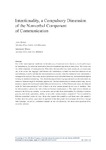Intentionality, a compulsory dimension of the nonverbal component of communication

Ver/
Use este enlace para citar
http://hdl.handle.net/2183/13316Coleccións
Metadatos
Mostrar o rexistro completo do ítemTítulo
Intentionality, a compulsory dimension of the nonverbal component of communicationData
2012Cita bibliográfica
Culture of communication / Communication of culture, 2012: 1125-1132. ISBN: 978-84-9749-522-6
Resumo
[Abstract] One of the most important conditions for the adequacy of communication process is, as it’s well known, the intentionality, by which the information between transmitter and receiver takes place. This is the case for verbal component of communication. What about the nonverbal one, more exactly, do we consciously use, or do us not this language? And because the intentionality is based on conscious character of our inter-relations, it can be said that the communication occurs only when the transmitter send intentionally a message to the receiver. This would include speech and some nonverbal behaviors, such as different aspects pointing or attention maintaining. From the producing and receiving signs perspective, the intentional and conscious behavior might be differently approached. The tacit dimensions of communication may have an enormous impact for interlocutor further behavior and reactions. As Paul Watzlawick stated, the behavior might be “non-communicative” only if there is no other person around (in one way or another). Once the other person is present, the whole behavior becomes communicative. The paper aims to identify an answer to the following question: to what extent can we talk about intentionality, by referring to posture, gestures, and facial expressions, shortly, to nonverbal communication component? This is justified by different researches’ points of view: those who support this possibility and those ones who amend it. Another issue the present paper aims to approach is that that people send messages about them through body language, but not in a declarative manner, as part of a discourse; this raises some questions about nonverbal valences
ISBN
978-84-9749-522-6





